How to Reduce Spam Email A Practical Guide
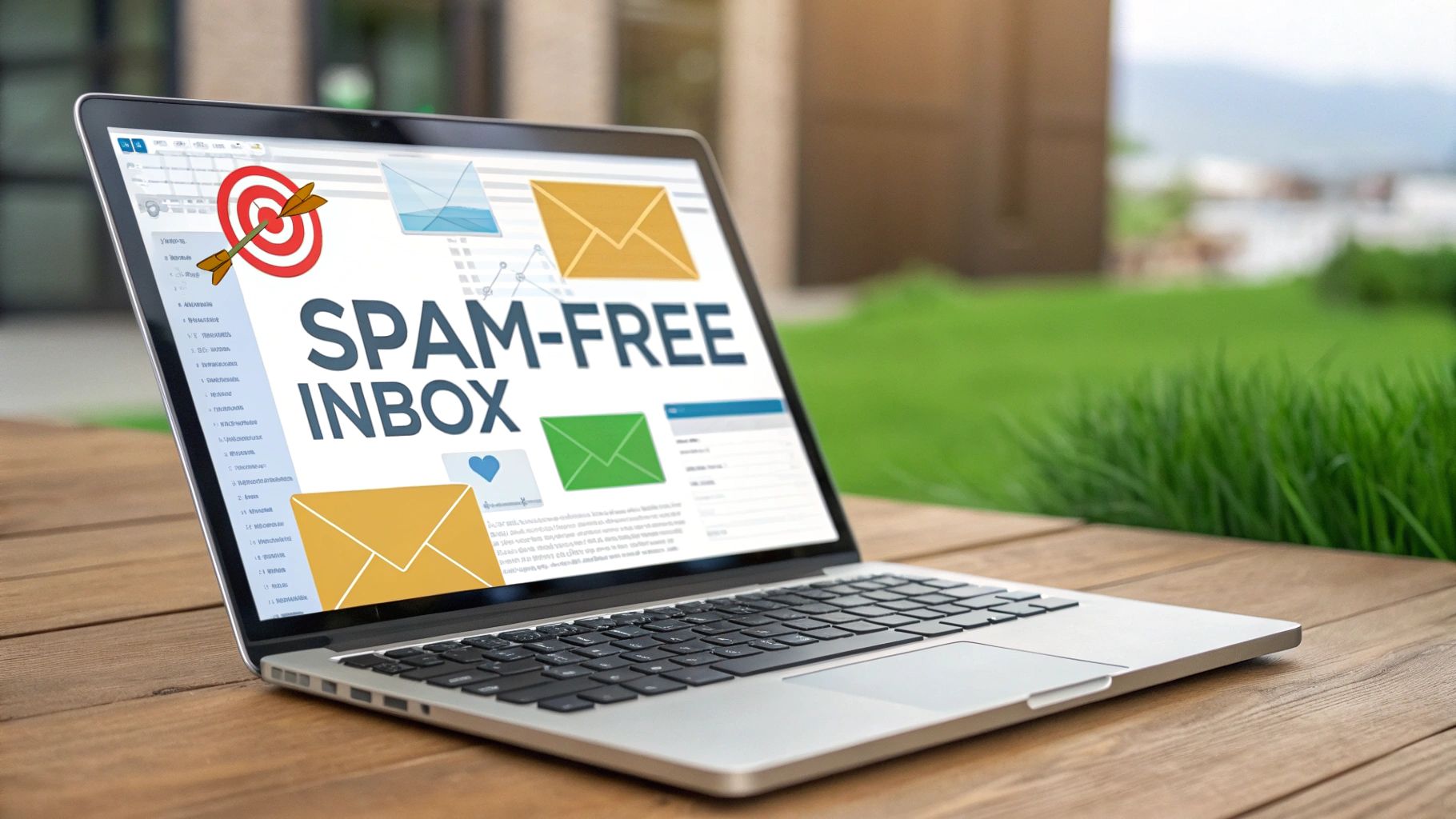
Fighting off spam feels like a never-ending battle, but you can win. It takes more than just dragging emails to the junk folder; it requires a smart, layered approach. Think of it as building a digital fortress around your inbox by being strategic about where you share your email, using the right tools to filter what gets in, and knowing how to spot real threats.
Winning the War on Inbox Clutter
Let's be honest: spam is more than just annoying. It’s a relentless flood that buries important messages and, worse, opens the door to serious security risks. The sheer volume is staggering—spam makes up over 45% of all emails sent, which is about 14.5 billion junk messages hitting the internet every single day. For the average person, that adds up to more than 1,800 unwanted emails a year. You can dig deeper into these email spam statistics over at AgainstData.
With that much junk flying around, your email provider’s default filter just can’t keep up. While a completely spam-free inbox might be a myth, you can absolutely slash the amount of noise you have to deal with. This guide gives you practical, effective ways to do just that.
Your Core Anti-Spam Strategy at a Glance
A solid defense against spam isn't about one magic fix. It’s built on three core pillars that work together. Each one tackles a different part of the problem, from stopping spam before it starts to handling the messages that inevitably slip through.
Here’s a quick breakdown of how these pillars fit together:
| Strategy Pillar | Your Role | Key Action |
|---|---|---|
| Proactive Habits | The Gatekeeper | Be selective about sharing your main email; use aliases for subscriptions and sign-ups. |
| Smart Tools & Filters | The Organizer | Set up custom rules and use advanced tools like the best email spam filters available to automate sorting. |
| Security Awareness | The Defender | Learn to recognize phishing attempts and malicious links hidden in seemingly harmless spam. |
By mastering these three areas, you create a powerful system that cleans up your inbox today and keeps it protected from future clutter and cyber threats.
The most effective way to reduce spam email is to treat your primary email address like a private phone number—share it carefully and protect it with powerful, modern tools.
This combination of good habits, smart technology, and a little bit of vigilance is your best bet for reclaiming your inbox and your focus.
Building Your First Line of Digital Defense
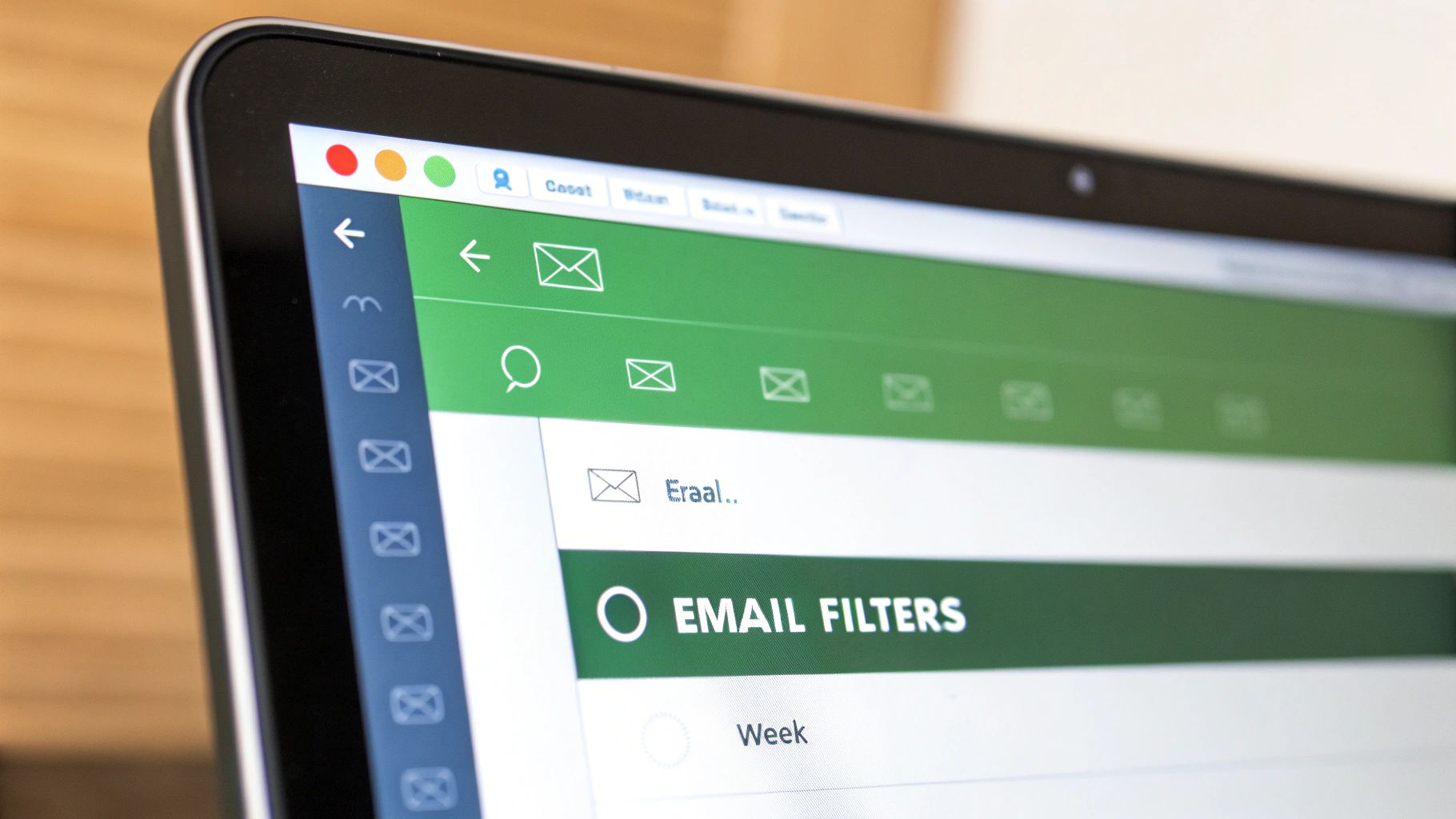
If you really want to cut down on spam, you have to stop thinking like a janitor and start acting like a bouncer. It's not about endlessly cleaning up the mess after it arrives; it's about setting up a velvet rope to keep the riff-raff out from the very beginning.
This all starts with knowing what to do with the junk that slips through. When you get an email from a company you actually signed up for but no longer want to hear from, just hit their unsubscribe link. It’s a clean break. But for those random, sketchy emails? Always, and I mean always, use your email client’s “Report Spam” or “Junk” button.
That simple action makes a huge difference. Unsubscribing just tells one company you’re out. Reporting spam, however, is like giving your email provider’s security system a new piece of intel. It learns what to look for, helping protect you—and everyone else—from similar junk in the future.
Create a Digital Decoy
Here’s my single most effective tip for anyone serious about a clean inbox: protect your primary email address at all costs. Treat it like your personal phone number—you wouldn't post it on a public bulletin board, right?
For everything else—that one-time online purchase, a newsletter you’re just testing out, or a free PDF download—use a disposable or alias email address.
Tools like Typewire make this incredibly easy. You can create multiple secondary addresses that all feed into your main inbox. The moment one of those aliases gets bombarded with spam, you just delete it. Poof. The spam source is cut off, and your real inbox remains untouched.
Think of your primary email as a valuable asset. Guarding it with aliases for all non-essential sign-ups is the best habit you can build to dramatically reduce future spam.
This strategy is your best defense against a relentless global problem. Consider the sheer volume: China and the United States alone are home to the most spam-sending IP addresses, with over 771,000 and 677,000, respectively. You can dig into more of these fascinating global spam patterns at EmailToolTester.
Given those numbers, just being selective about who gets your real email address creates an incredibly strong first line of digital defense.
Customizing Filters for a Smarter Inbox
Good email habits are a great start, but the real power comes when you teach your email client how to think for you. Your standard spam folder is decent at catching the most obvious junk, but custom filters are like having a personal gatekeeper for your inbox. You get to set the rules.
Think of it as creating a bouncer with a very specific guest list. These rules can go way beyond just a sender's address. For instance, I've set up filters that automatically trash any email with cliché sales phrases like “limited time offer” or “final notice.” It’s a surprisingly effective trick for cutting out the noise from low-effort marketing campaigns.
And before you even start building complex filters, one of the easiest wins is simply unsubscribing from newsletters you no longer read. It's a fundamental step to clearing out your inbox.
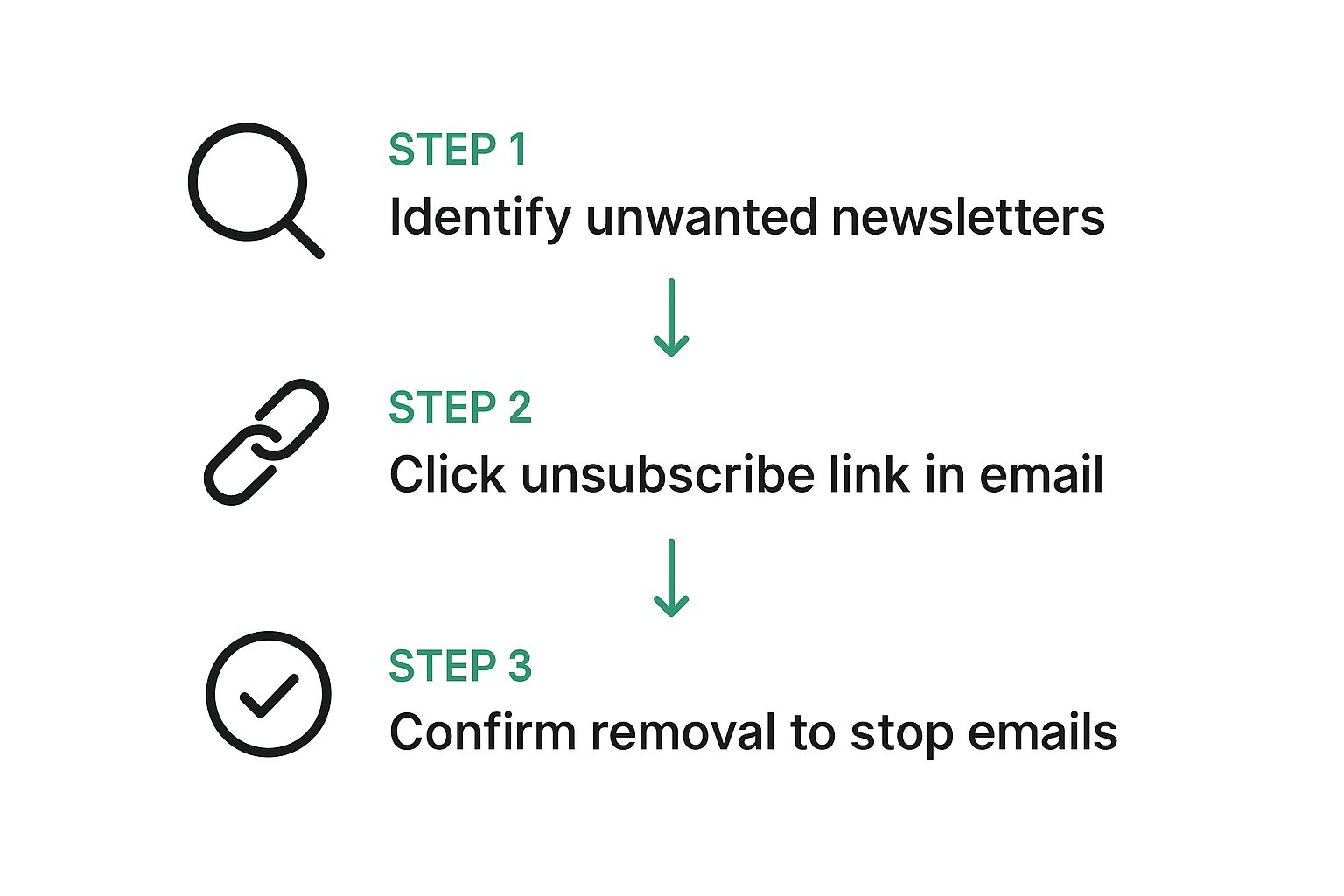
As you can see, systematically removing yourself from mailing lists you don’t find valuable anymore is often the first, most impactful move you can make.
Fine-Tuning Your Sorting Logic
Once you've trimmed the fat, you can get more sophisticated with whitelists and blacklists to really sharpen your inbox's logic. These are your "always allow" and "never allow" lists.
- Whitelisting: This is your VIP list. Any sender you add here will bypass all your other filters and land directly in your primary inbox. It's perfect for making sure you never miss an email from critical clients, your boss, or family.
- Blacklisting: This is the opposite—a permanent block. You can blacklist a specific sender or, even better, an entire domain (like @.spam-domain.com). This is far more powerful than just marking one email as spam; it cuts off the source for good.
I once dealt with a wave of spam coming from different addresses but all from the same shady domain. Instead of playing whack-a-mole, I just blacklisted the entire domain. Problem solved, instantly.
The goal is to shift from passively reporting spam to actively training your email client. A few smart filters can automate the sorting you do manually every day, saving you hundreds of clicks and a surprising amount of time in the long run.
Taking this hands-on approach really does turn your email from a dumb mailbox into a smart assistant that knows what's actually important to you.
How to Spot and Defeat Phishing Attacks
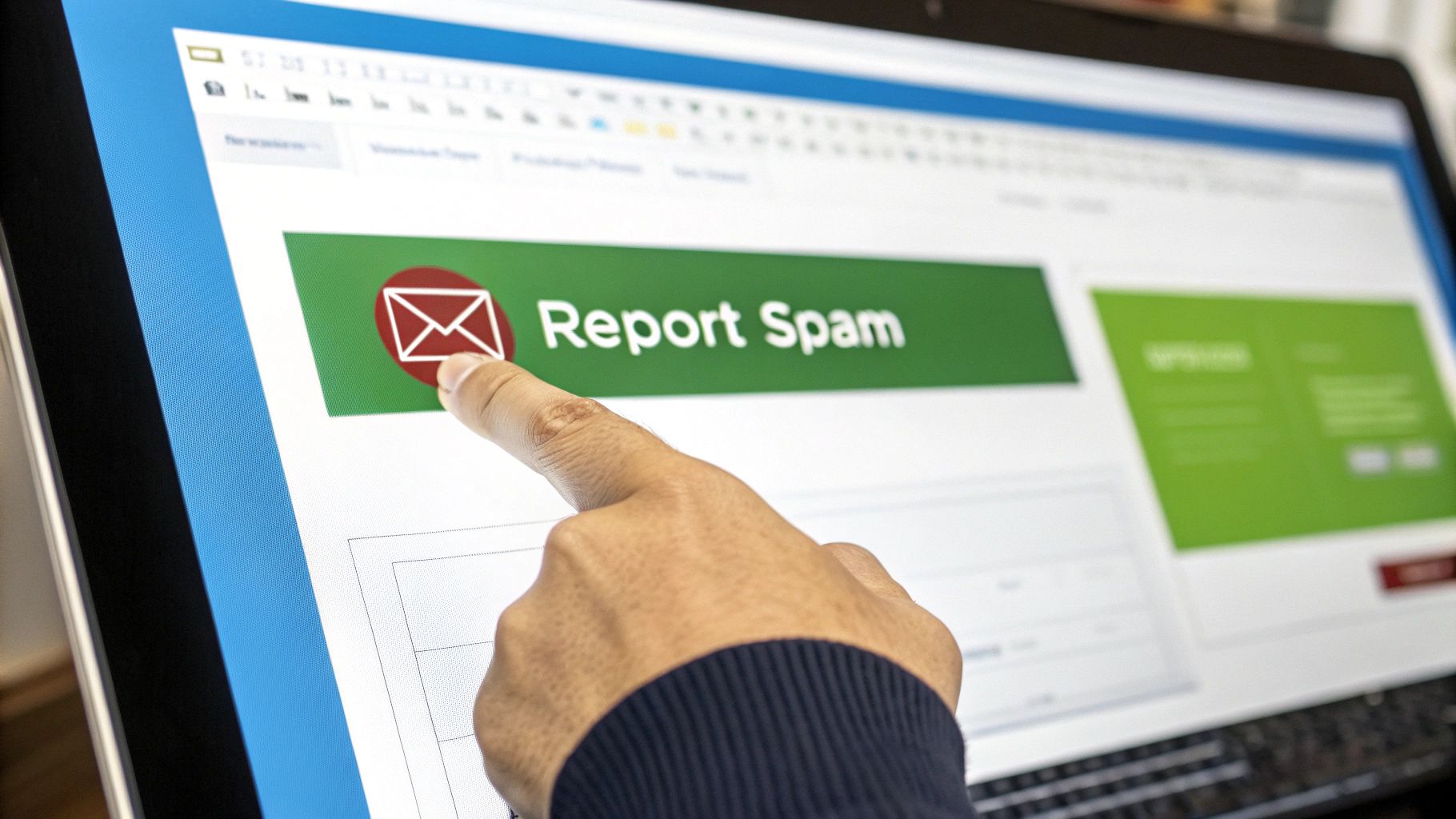
While most spam is just digital noise, some of it is downright dangerous. I'm talking about phishing attacks—cleverly disguised emails that mimic legitimate companies to trick you into handing over passwords, credit card numbers, or other sensitive data. Honestly, it's the most hazardous type of spam you'll ever find in your inbox.
The sheer volume of this threat is staggering. Attackers blast out over 3.4 billion phishing emails every single day across the globe. It's a constant, relentless assault. This method is so effective that it’s the gateway for 94% of all malware infections and is linked to a shocking 80% of reported cybercrimes.
Learning to spot these fraudulent emails isn't just a "nice-to-have" skill; it's essential for protecting yourself.
Your Mental Checklist Before You Click
Scammers count on you being busy. They want you to react emotionally, not rationally. Before you click any link or download an attachment, pause for a moment and run through a quick mental checklist. Those few seconds of scrutiny can be the difference between safety and a massive headache.
Here are the dead giveaways I always look for:
- Mismatched Sender Details: Don't just glance at the sender's name. Hover your mouse over it (or long-press on mobile) to reveal the actual email address. A message from "PayPal" that comes from an address like
support-desk-2451@random-server.comis an immediate red flag. - Urgent or Threatening Language: Phishing emails almost always try to create a false sense of emergency. Look for subject lines like “Action Required: Your Account is Locked” or “Suspicious Login Attempt.” They’re trying to scare you into clicking before you can think.
- Awkward Grammar and Spelling: While some attacks are very polished, many are still riddled with typos, strange phrasing, or grammatical errors that a real company’s communications team would have caught.
The single most powerful habit you can build is to always assume an email is suspicious until you've verified its legitimacy. This mindset shift turns you from a potential target into a confident defender.
Stay on the lookout for more advanced tactics, too. Spear phishing involves hyper-personalized attacks where criminals use details they found about you online to sound more convincing. There's also quishing, a newer trend where they use malicious QR codes in emails.
If you want to dive deeper, our complete guide on how to identify phishing emails is packed with expert tips to keep you safe.
Understanding How Email Authentication Works
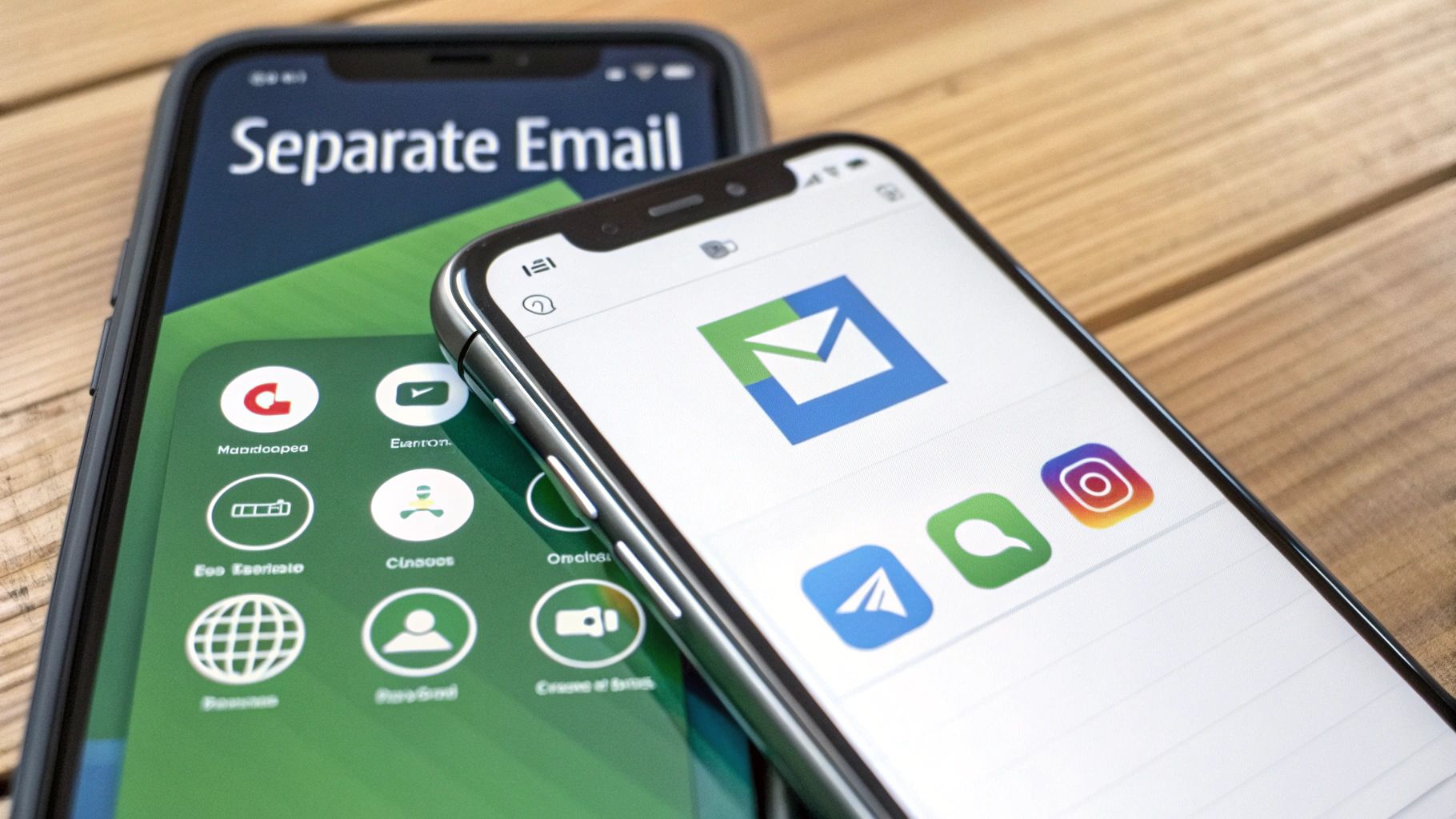
Ever wondered what really happens when an email lands in your inbox? There’s a lightning-fast security check that happens behind the scenes, all designed to separate genuine messages from clever forgeries. This process, known as email authentication, is your first and best line of defense against the daily onslaught of spam.
Think of it as a bouncer at a club checking an ID. When an email shows up, the receiving server (whether it's Gmail or Typewire) looks for special credentials to confirm the sender is who they say they are. This is what stops a scammer from just faking a trusted address—like support@yourbank.com—and waltzing right into your primary inbox.
This entire verification process hinges on a trio of security standards that work in concert to guard your email.
The Three Pillars of Email Trust
You don't need to be a network engineer to grasp the basics. Each of these protocols adds a unique layer of verification, and when used together, they make it incredibly difficult for spam and phishing attacks to succeed.
- SPF (Sender Policy Framework): This is the foundational check. Think of it as a public list of approved mail carriers. A domain owner publishes a list of all the servers that are officially allowed to send emails for them. If a message comes from a server that isn't on the list, it immediately raises a red flag.
- DKIM (DomainKeys Identified Mail): This one adds a tamper-proof digital signature to every email—like an unbreakable wax seal on an old-fashioned letter. This signature proves that the message content hasn't been altered or messed with on its way to you.
- DMARC (Domain-based Message Authentication, Reporting & Conformance): DMARC is the rule-setter. It tells receiving email servers exactly what to do when a message fails either the SPF or DKIM check. The instructions can be to quarantine it in the spam folder or to reject it outright so it never even gets delivered.
These three protocols form a powerful shield. When a sender has them set up correctly, they prove an email is both from the right place and hasn't been forged, a critical step in automated spam detection.
If you're interested in diving a bit deeper, you can learn more about what email authentication is in our complete security guide. Getting familiar with these concepts helps explain why some junk mail still slips through and, just as importantly, why legitimate emails sometimes get mistakenly flagged as spam.
Got Questions? We’ve Got Answers on Beating Spam
Even with the best tools in your arsenal, fighting spam can bring up a few questions. I've heard these a lot over the years, so let's walk through some practical answers to help you lock down your inbox for good.
Does Reporting Spam Actually Do Anything?
Yes, it absolutely does. Hitting that "Report Spam" button in Gmail, Outlook, or Typewire does far more than just clean up your personal inbox.
You're essentially sending up a flare. This action feeds crucial data back to the email provider, training their spam-fighting algorithms to spot and block similar junk for everyone. Think of it as a community watch program for your inbox—it’s one of the most effective ways we can collectively shut down spammers.
Reporting spam is like contributing a piece to a massive puzzle. Your one click helps build a clearer picture of spammer tactics, making the entire email ecosystem safer and more secure.
Just remember: unsubscribing is for legitimate marketing you're tired of, while reporting spam is for the malicious junk you never signed up for in the first place.
What If My Email Was in a Data Breach?
Finding out your email was exposed in a data breach can be alarming, but the key is to act swiftly, not panic. Your first move should be to change your password on that account immediately. If you've used that same password elsewhere—and we’ve all done it—change it on those accounts, too.
Next, turn on two-factor authentication (2FA) wherever it's offered. It’s a simple step that provides a massive security boost, protecting your account even if a scammer gets their hands on your password. After a breach, you should also be on high alert for phishing emails. Scammers will use the stolen data to craft very personal and convincing attacks. This is where using aliases for new sign-ups can really pay off by limiting the fallout from future breaches.
Are Paid Anti-Spam Services Worth It?
For most of us, the free, built-in filters from modern email providers do a pretty solid job. They catch the obvious stuff and keep our inboxes relatively clean.
However, for businesses or anyone dealing with highly sensitive information, a dedicated paid service can be a game-changer. These platforms offer much more granular control, advanced filtering techniques, and dedicated support that you just don't get with standard consumer accounts. If you're a potential high-value target for spear phishing or just want the tightest security possible, investing in a specialized service is often money well spent. It really boils down to your personal risk tolerance.
Ready to take back your inbox with an email service built for privacy and security? Typewire offers advanced anti-spam and virus protection without tracking or ads. Start your free 7-day trial of Typewire today!
How to Reduce Spam Email A Practical Guide
Posted: 2025-07-10
Data Residency Requirements for Secure Hosted Email
Posted: 2025-11-29
Your Data Breach Response Plan for Hosted Email Security
Posted: 2025-11-28
PGP Encryption Online: A Guide to Secure Email
Posted: 2025-11-27
What Is a Digitally Signed Email?
Posted: 2025-11-26
How to host email server for privacy and security
Posted: 2025-11-25
what is a mail server: A guide to email privacy and security
Posted: 2025-11-24
What Is Email Hosting and Why Does It Matter?
Posted: 2025-11-23
Hosting a Mail Server: A Practical Guide to Email Privacy and Security
Posted: 2025-11-22